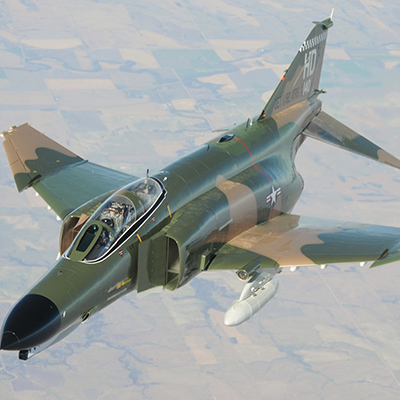Warfare
Phantom
Emad Ezatabadi
145 دورہ
The Phantom, or F-4, is an American-made fighter jet that entered service in Iran in 1968 and played a critical role during the Iran-Iraq War, serving in both combat and reconnaissance missions as a cornerstone of Iran’s air operations.
The term “Phantom”, meaning “ghost”, refers to the twin-engine, two-seat F-4 fighter jet, designed by the American company McDonnell Douglas. It made its first flight on May 27, 1958.[1] This fighter-bomber and air interceptor, powered by two turbojet engines, can exceed twice the speed of sound. These engines enable the Phantom to climb beyond 30 kilometers in altitude and cover a range of over 3700 kilometers without aerial refueling.[2] The aircraft can carry more than 8 tons of various munitions, including bombs, missiles, and rockets, across nine external hardpoints, and is equipped with a 20 mm M-61 Vulcan cannon.[3] Designed for the United States Navy to operate from aircraft carriers, the Phantom played a significant role in the US attack on Vietnam. The air forces of several countries, including Japan, Egypt, Turkey, Greece, the UK, Germany, Iran, and others also used this aircraft.[4]
Iran was the first country after the US and the UK to operate the Phantom. The initial batch delivered to Iran was the F-4D variant, received on September 18, 1968, leading to the formation of Iran’s first Phantom squadron at Mehrabad’s 1st Air Base in Tehran.[5] In 1971, Iran received the more advanced variant, F-4E, available in both combat and reconnaissance configurations. The reconnaissance variant, equipped with multiple advanced cameras, enabled aerial photography of various targets.[6] Iran purchased 32 F-4D Phantoms in 1968, 177 F-4E Phantoms, and 16 RF-4 reconnaissance Phantoms in 1971 from the United States.[7] The large number of Phantoms and their versatility made them the backbone of the Iranian Air Force.
At the onset of the Iran-Iraq War in 1980, out of 196 F-4s stationed at the 1st, 3rd, 6th, and 9th fighter bases, only 147 were operational.[8] On the first day of the war, four Phantoms took off from the 6th Air Base in Bushehr and bombed the Shuaiba Air Base in Basra,[9] while another four from the 3rd Air Base in Hamedan targeted the Kut Air Base in al-Amarah.[10]
On September 23, 1980, during Operation Kaman 99, 16 Phantoms struck the Kut Air Base in al-Amarah, 12 targeted the Shuaiba Air Base in Basra, and 12 hit the al-Rashid Air Base in Baghdad, damaging Iraq’s air force capabilities.[11]
One of the Phantom’s key missions was to destroy the Iraqi army’s armored units at the frontlines. These operations not only crippled the enemy’s armored capabilities and instilled fear in Iraqi forces but also boosted the morale of Iranian troops defending the frontlines. On some days during the war, Phantoms conducted up to 150 bombing missions, making strong attacks on the enemy.
Another key mission of the Phantoms was the destruction of Iraqi refineries, utilizing a diverse array of munitions, including general-purpose Mark-series bombs, laser-guided bombs, TV-guided bombs, cluster bombs, and incendiary bombs. However, targeting the Baathist regime’s Osa-class missile boats was a distinct challenge, as the absence of anti-ship missiles required the use of four or five Maverick missiles.[12] By flying at high altitudes and releasing bombs on enemy targets, Phantoms inflicted significant damage on the enemy’s equipment and personnel. This was one of their most commonly employed bombing tactics.[13]
One notable operation involving Phantoms was Operation H-3 which was carried out on April 4, 1981. In this operation, eight Phantoms covered a 1700-kilometer route to strike the al-Walid airbases, executing one of the most extraordinary air operations in history, which resulted in the destruction of 50 enemy aircraft.[14] Another critical role of the Phantoms was reconnaissance missions, known as Operation Nasser, conducted in coordination with radar stations, fighter controllers, and other units.[15] These missions provided commanders and operation planners with precise information about the enemy troops, equipment, deployment patterns, and locations.
In order to show the security of its territory and build global consensus against the Islamic Republic of Iran, the Iraqi regime called for hosting the Non-Aligned Movement summit in 1982. However, on July 21, 1982, two Phantoms targeted Baghdad’s al-Doura refinery thereby raising concerns about the security of the country. Finally, the summit was not held in Iraq. In this attack, Abbas Doran, the commander of the operation, sacrificed his life.[16]
As the war prolonged and Iraq introduced MiG-25 aircraft to the battlefield, the Iranian Army Air Force had to be equipped with suitable missiles to counter them. Therefore, by converting the radar of the Standard anti-ship missile into an air-to-air radar and installing it on Phantoms, Iranians gained the capability to engage intruding MiGs.[17]
Beyond destroying strategic bridges, refineries, military bases, and key Iraqi ports, Phantoms participated in most major operations throughout the eight-year Iran-Iraq War. These included an operation the 144th Infantry Battalion carried out in Mahshahr Port on October 25, 1980; Operation Shabah 2 launched in support of Operation Thamen al-Aemmah (as) on March 28, 1981; Operation Shabah 3 conducted in support of Operation Fath al-Mobin on February 26, 1982; supporting Operation Beit al-Muqaddas on April 20, 1982; Operation Shafaq carried out in support of Operation Valfajr 8 in 1986; and backing the Operation Mersad on July 26, 1988.[18]
Over the eight years of the war, F-4 aircraft conducted 57000 sorties, excluding refueling missions. By the war’s end in 1988, 106 F-4s had been lost in various missions.[19] During the war, Manouchehr Mohaqeqi completed 182 sorties, the highest number of combat missions flown by any Phantom pilot.[20] Notable Phantom pilots included Mahmoud Eskandari and martyrs Feridoun Zolfaghari, Alireza Yasini, Abbas Doran, and Hussain Khalatbari.[21]
After the war, Phantom squadrons continued to form a vital part of Iran’s air capabilities.[22] They were upgraded and equipped with new systems and weapons[23] and remained fully operational.
[1] Alibabaei, Gholamreza, Tarikh-e Niru-ye Havayi-ye Iran az Pahlavi ta Enqelab (The History of Iran’s Air Force from Pahlavi to the Revolution), Tehran, Ashiyan, 1383, p. 390.
[2] Ibid., p. 102.
[3] Mahname Sanaye Havayi (Sanaye Havayi Monthly), Sal 23, Sh. 263, Tir 1392, p. 1.
[4] Alibabaei, Gholamreza, Ibid., p. 390.
[5] Ibid., p. 102.
[6] Babaei, Muhammadreza, Balhaye Qodrat-e Havayi (Wings of Air Power), Tehran, Markaz Entesharat Rahbordi Nahaja, 1398, p. 148.
[7] Alibabaei, Gholamreza, Ibid., Pp. 439, 440.
[8] Habibi, Nikbakhsh va Ali Gholami, Defa Muqaddas-e Havayi (The Sacred Air Defense), Tehran, Markaz Entesharat Rahbordi Nahaja, 1397, p. 729.
[9] Khamehyar, Muhammad, Avalinha-ye Defa Muqaddas (The Firsts during the Sacred Defense), Tehran, Parsaandish, 1389, Pp. 120, 121, 122.
[10] Namaki, Alireza, Niru-ye Havayi dar Defa Muqaddas (The Air Force during the Sacred Defense), Tehran, Iran Sabz, 1389, p. 121.
[11] Ibid., Pp. 131, 133.
[12] Pishahang - Mosahabeh ba Amir Sartip Dovom Khalaban Masoud Eqdam (Interview with Second Brigadier General Pilot Masoud Eqdam), Mahname Sanaye Havayi, Sal 23, Sh. 263, Tir 1392, Pp. 15, 16.
[13] Farshi az Bomb - Mosahabeh ba Moallem Khalaban Phantom Nasser Rezaei (Interview with Phantom Pilot Nasser Rezaei), Mahname Sanaye Havayi, Sal 22, Sh. 257, Dey 1391, p. 13.
[14] Mehrnia, Ahmad, Hamle-ye Havayi be al-Walid (H-3) (The Air Strike on Al-Walid (H-3)), Tehran, Sura Mehr, 1395, p. 19.
[15] Namaki, Alireza, Ibid., p. 160.
[16] Qazi-Mirsaeed, Seyyed Hekmat, Bombi dar Cabin (A Bomb in the Cockpit), Tehran, Bonyad Hefz Asar va Nashr Arzesh-haye Defa Muqaddas, 1388, p. 177.
[17] Namaki, Alireza, Ibid., p. 324.
[18] Ibid., Pp. 9, 10.
[19] Habibi, Nikbakhsh va Ali Gholami, Ibid., Pp. 729, 730.
[20] Recorddar Parvaz Razmi Boroun Marzi ba Phantom Darfani ra Veda Goft (The Record Holder for Cross-border Combat Flights with the Phantom Passed away), Khabargozari IRNA, 9 Mehr 1400, https://www.irna.ir/news/84489796
[21] Bartarin Khalabanan-e Iran dar Doran-e Defa Muqaddas (The Best Iranian Pilot during the Sacred Defense), Khabar Online, 27 Shahrivar 1399, https://www.khabaronline.ir/news/1433609
[22] Mahname Sanaye Havayi (Sanaye Havayi Monthly), Sal 22, Sh. 262, Khordad 1392, Pp. 2, 3.
[23] Nosrati, Mehrdad, Koochaktarin Tahdid Doshmanan ra Koobande-tar Pasokh Khahim Dad: Goftogu ba Farmande-ye Paygah-e Havayi-ye Shahid Abdolkarimi Bandar Abbas (We Will Respond to Even the Smallest Enemy Threats more Forcefully: Interview with the Commander of Shahid Abdolkarimi Air Base in Bandar Abbas), Mahname Saf, Sal 98, Sh. 463, Esfand 1398, p. 22.





